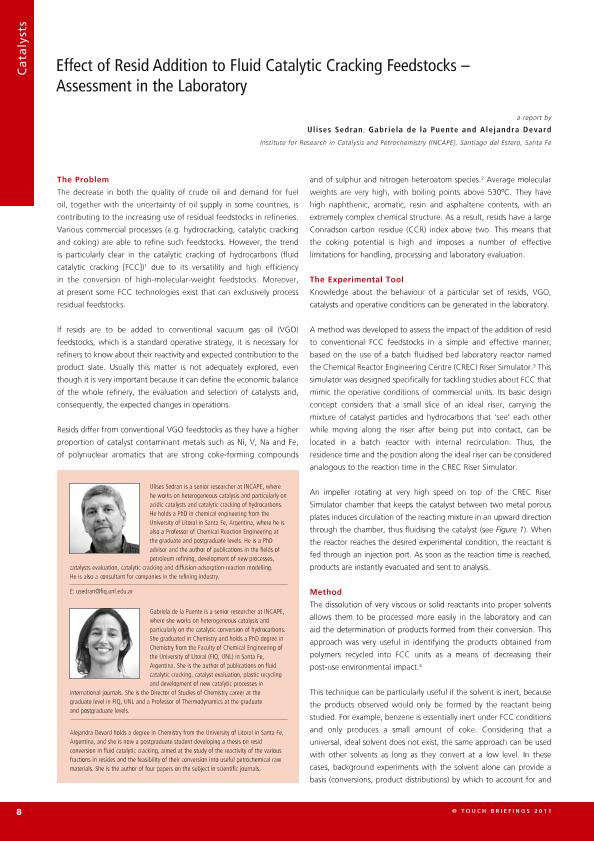Mostrar el registro sencillo del ítem
dc.contributor.author
Sedran, Ulises Anselmo

dc.contributor.author
de la Puente, Gabriela

dc.contributor.author
Devard, Alejandra Veronica

dc.date.available
2018-07-26T16:26:45Z
dc.date.issued
2011-06
dc.identifier.citation
Sedran, Ulises Anselmo; de la Puente, Gabriela; Devard, Alejandra Veronica; Effect of resid addition to FCC feedstocks. Assessment in the laboratory; Touch Briefings; Hydrocarbon World; 6; 6-2011; 8-11
dc.identifier.issn
1753-3899
dc.identifier.uri
http://hdl.handle.net/11336/53169
dc.description.abstract
The decrease in both the quality of crude oil and the demand of fuel oil, together with uncertainty in the oil supply in some countries, contribute to the increasing use of residual feedstocks in refineries. While various commercial processes (e.g. hydrocracking, catalytic cracking, coking) are able to process them, the trend is particularly perceivable in the catalytic cracking of hydrocarbons (FCC) due to its versatility and high efficiency in the conversion of heavy molecular weight feedstocks. Moreover, at present, some FCC technologies exist that can process residual feedstocks exclusively. If resids are to be added to conventional vacuum gas oils (VGO) feedstocks, which is a rather standard operative strategy, then, it is necessary for refiners to know about their reactivity and their expected contribution to the product slate. Usually this matter is not explored adequately, even though it is very important because it can define the economic balance of the whole refinery, the evaluation and selection of catalysts and, consequently, the expected changes in operations. Resids differ from conventional VGO feedstocks in their higher content of catalyst contaminant metals such as Ni, V, Na and Fe, of polynuclear aromatics that are strong coke forming compounds, and of sulfur and nitrogen heteroatom species. Average molecular weights are very high, with boiling points above 530 ºC. They have a high content of naphthenics, aromatics, resins and asphaltenes, with a extremely complex chemical structure. It is a consequence that resids have a large CCR Conradson carbon index, above 2, which means that the coking potential is high, and impose a number of effective limitations for handling, processing, and laboratory evaluation.
dc.format
application/pdf
dc.language.iso
eng
dc.publisher
Touch Briefings
dc.rights
info:eu-repo/semantics/openAccess
dc.rights.uri
https://creativecommons.org/licenses/by-nc-sa/2.5/ar/
dc.subject
Fcc
dc.subject
Resid
dc.subject
Catalyst Evaluation
dc.subject
Fuels
dc.subject.classification
Otras Ingeniería Química

dc.subject.classification
Ingeniería Química

dc.subject.classification
INGENIERÍAS Y TECNOLOGÍAS

dc.title
Effect of resid addition to FCC feedstocks. Assessment in the laboratory
dc.type
info:eu-repo/semantics/article
dc.type
info:ar-repo/semantics/artículo
dc.type
info:eu-repo/semantics/publishedVersion
dc.date.updated
2018-07-20T14:18:46Z
dc.journal.volume
6
dc.journal.pagination
8-11
dc.journal.pais
Reino Unido

dc.journal.ciudad
Londres
dc.description.fil
Fil: Sedran, Ulises Anselmo. Consejo Nacional de Investigaciones Científicas y Técnicas. Centro Científico Tecnológico Conicet - Santa Fe. Instituto de Investigaciones en Catálisis y Petroquímica ; Argentina
dc.description.fil
Fil: de la Puente, Gabriela. Consejo Nacional de Investigaciones Científicas y Técnicas. Centro Científico Tecnológico Conicet - Santa Fe. Instituto de Investigaciones en Catálisis y Petroquímica ; Argentina
dc.description.fil
Fil: Devard, Alejandra Veronica. Consejo Nacional de Investigaciones Científicas y Técnicas. Centro Científico Tecnológico Conicet - Santa Fe. Instituto de Investigaciones en Catálisis y Petroquímica ; Argentina
dc.journal.title
Hydrocarbon World
Archivos asociados
